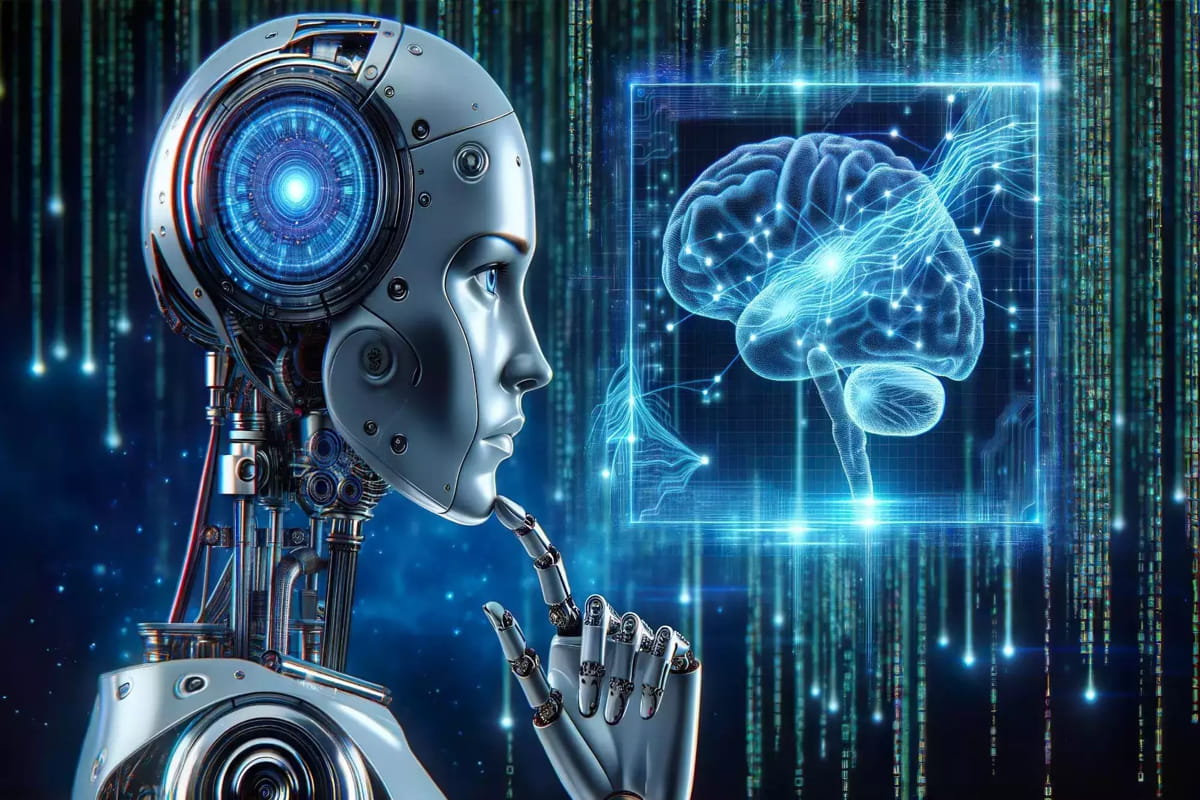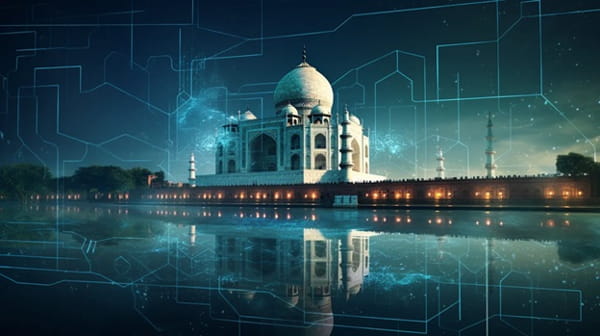
Representative image. | SciTechDaily.com.
The AI age is upon us. Developments in AI technology as well as on governance and regulatory aspects are moving at breakneck speed. Geopolitically, the race is on for AI supremacy. India is well poised to be an early starter and has moved fast in the last five years. It has the attributes to be in the ‘Circle of Three’. A Long Paper on AI in three parts by NatStrat.
ACKNOWLEDGEMENTS
This Paper is the outcome of consultations hosted by the Convenor of NatStrat, Pankaj Saran, with a group of experts in the tech, finance and AI space over many months. They are Sharad Sharma, co-founder of iSPIRT Foundation, a non-profit technology think-tank that has conceptualized India Stack, Health Stack and other digital public goods; Sanjay Anandaram, a Council member of iSPIRT, Executive Committee member of IIIT Bangalore-housed Mosip.io, the world’s largest Digital Public Goods deployed initiative, and part of the THINK20 initiative under the Italian Presidency of the G20 in 2021; Surya Kanegaonkar, a commodities trader and columnist based in Switzerland who has held key roles in the natural resources sector, working for an investment bank and utilities; and another expert who joined without attribution. NatStrat Researchers Siddhant Hira and Prateek Kapil coordinated the consultation process and editing of the paper.
Disclaimer:The views projected in the Paper are exclusively those of NatStrat and do not necessarily reflect the views of individual members or the group.
This Paper is the first of a three-part series by Team NatStrat. The authors review the global landscape, lay out India’s goal to be in the ‘Circle of Three’, and review what other countries are doing.
SYNOPSIS
The AI age is upon us. Developments in the technology itself as well as on governance and regulatory aspects are moving at breakneck speed, even since the writing of this paper. Geopolitically, the race is on for AI supremacy. The question is who will win the race. India has moved fast in the last five years. The question is whether this is fast enough. India is well poised to be an early starter and not miss the bus this time. It also rightly believes it is poised to be one of the drivers of the AI bus rather than just a passenger.
This paper consists of separate sections starting with a review of what other countries are doing, the perfectly plausible scenario of India being in the circle of Three (C3), the benefits to India of AI, what India has done so far and what are its advantages, finally concluding with a set of recommendations on what India should do.
THE DEEPSEEK DISRUPTION

Representative image. | YourStory.
On January 20, 2025 the first day of his second term in office, US President Donald Trump signed an Executive Order that rescinded a 2023 Executive Order signed by his predecessor Joe Biden on Artificial Intelligence (AI). President Biden wanted AI developers to align with the Defense Production Act because he believed AI poses an unprecedented risk to national security, consumers and workers. President Trump decided that these regulatory guardrails were unnecessary. He announced that OpenAI, Oracle and SoftBank have together pledged a $500 billion investment over the next five years to create AI infrastructure—including data centres—under a joint venture called Stargate. He claimed that this investment would “almost immediately” create 100,000 jobs.
The same day, far away in Hangzhou, China a new AI model, DeepSeek-R1 was released by a startup. News of its superior performance over ChatGPT spread like wildfire. Within no time, it became the most downloaded free app on the App Store. The global AI stock market was devalued by one trillion dollars and Nvidia lost $589 billion in value, the most for a single stock in market history. The app was trained at a cost of a mere $6 million and the data required to run it was much less than ChatGPT. DeepSeek had managed with microchips with lower computational power because the US government had made top-shelf AI-centric microchips, such as those manufactured by Nvidia, inaccessible.
As one technology expert pointed out this was a Sputnik AI moment but without Soviet era secrecy since DeepSeek is an open-source app and can be replicated by any developer across the world. On January 30, 2025 the Indian government said DeepSeek, an open-source model, would soon be hosted on Indian servers and data centres to address data security and privacy concerns over the Chinese AI platform.
India expects that multiple efforts will be undertaken in India (in universities and companies) where existing models of DeepSeek will be installed locally, and fine-tuned with India-specific or domain-specific data.
INDIA’S GOAL: CIRCLE OF THREE (C3)

Representative image. | AIWeeklyReport
In an era characterized by relentless technological advancement, a nation's economic growth trajectory hinges on its ability to harness the power of artificial intelligence (AI). According to Goldman Sachs, generative AI could raise global GDP by 7%. By 2030, this AI-driven Intelligence economy might add $15.7 trillion of new economic value as per Price Waterhouse Cooper’s research. With its burgeoning tech industry, diverse and large data pool and remarkable human capital, India stands on the vergeof an economic transformation that could either propel it to global leadership by leveraging this wave or leave it behind in absence of an enabling ecosystem. For political decision-makers the imperative to recognize and seize this opportunity cannot be overstated in view of India’s bid to become top three economies of the world. The availability of the Data Empowerment and Protection Architecture Training Cycle and passage of the Digital Personal Data Protection Billin Parliament in 2023 opens the door to immediate and strategic action via the creation of a large AI economy.
India’s potential edge in AI lies in its large talent pool, large data sets generated and rapid economic growth. By leveraging these, a competitive edge can be created that powers India into the Circle of Three (C3). Besides developing foundational models, India must create AI applications for healthcare, agriculture, infrastructure and urban planning, financial services and education. Artificial Intelligence (AI) will also drive foundational shifts in security, military and space capabilities and industries.
WHAT OTHERS ARE DOING
AI is expected to reach $4.8 trillion in market value by 2033, becoming a prominent force in digital transformation. However, access to AI infrastructure and expertise remains concentrated in a few economies. Just 100 firms, mainly in the US and China, account for 40% of global corporate R&D spending. Leading tech giants, such as Apple, Nvidia and Microsoft, each have a market value of around $3 trillion, rivalling the gross domestic product of the whole African continent. Market dominance, at both national and corporate levels, may widen technological divides, leaving many developing nations at risk of missing out on its benefits.
The US is the leader in AI technology and market adoption, or so was theconventionalwisdom till the advent of DeepSeek. The contender, China, with its clearly stated goal of being the world leader in AI by 2030, is under pressure after the US crackdown on exports of critical hardware, research collaborations, as well as from its own government’s regulations on generative AI. The US and China are nevertheless both investing heavily in AI. The EU – on the other hand – is working to create a new regulatory regime for AI by defining ‘high-risk’ uses: innovation is not on the agenda. The UK, which has invested over GBP 2.5 billion in AI since 2014, does not see the need for special regulation and is comfortable following the principles laid out by the OECD.
To be a developed country by 2047, and have high value-added capabilities, India has to own and harness a critical all-pervasive technology like AI. Our DPI (Digital Public Infrastructure) initiatives have demonstrated that in a short period of time India can lead the world in conceptualising, designing, developing, and deploying low-cost and high-impact solutions for transforming our economy and society. No other country has done this at India’s stage of development. (End of Part I. Parts II and III to follow)
(Exclusive to NatStrat)
References: